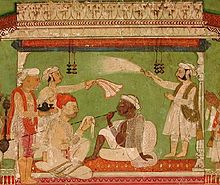During the reign of second Dibyasingh Dev (1793 – 1778), the Kshetrapala Bhairava statue and the statue of the head of the Gobardhan monastery (Matha), Padmapadacharya (the then Shankaracharya) were installed on the Ratna Singhasana. During that period, some Vaishnava (Ramanuja) Sect had forcibly broken the images of Kshetrapal Bhairava and Padmapadacharya and thrown them into the sea. They installed two statues of two Goddesses namely Sridevi & Bhudevi on the throne of Sri Jagannath in the place of Kshetrapal Bhairava and Padmapadacharya. During 1798, the then Shankaracharya and Dewan Jayee Rajguru had raised objection before the then king of Odisha, Raghoji Bhonsale II regarding this matter.

By the order of Raghoji Bhonsale, one new image of Kshetrapala Bhairava was built and installed at the Surya-Yantra Temple inside the Sri Jagannath temple premises. Subsequently, the East India company occupied Odisha. An objection was also filed on this regard before the East India Company. The then Collector of Puri Mr R. Hunter had submitted a report after due inquiry during the year 1806. But the East India Company remained silent over the matter (Anam – 19 page 27-28). Mr Hunter wrote in his report that it was an established fact that the image of Kshetrapal Bhairava was installed on the Ratna Singhasana of Lord Jagannath. But it was not finalised on which part of the throne, the statute of Bhairava was installed. In this connection no settlement between the Bairagi Group (Ramanuja) and Sanyasi Group (Shankrachraya Cult) could be made. The intellectual population were also divided into two religious sects. Not a single group came forward to become arbitrator on the problem to be settled. It was expected that the decision of the Board of Directors of East India Company would be obeyed by all. The company authority felt to remain silent on the Hindu religion conflict. After the inquiry report on 1806 AD. neither Gajapati (King of Puri), nor the Shankaracharya, nor the public of Puri, nor the Servitors complained before the Company directorate regarding solving this matter.

The Kshetrapal Bhairava was worshiped by the Pujapandas before worshiping Sri Jagannath. First they worship Dwarapala (Gate keepers of Sri Jagannath) and Surya (the Sun God). Then they worship Bhairava. They also worship the image of Goddess Kali and enter the main room of Sri Jagannath locally called Grabha Gruha. In Garbha Gruha they again worship Bhairava to protect the God and the Temple from all difficulties. In addition to that, the Pujapanda servitors hand over the power of worship to Daitapati Servitors for one month in connection with Ratha Yatra (From Snana Purnima to Niladri Bije). Before handing over the charge, the Pujapandas, worship the Bhairava for their security. The Bamadev Samhita composed by the learned person of Mukti Mandap reveals that the Bhairava or Kshetrapala is the first worshiped God of Sri Jagannath temple. On Snana Purnima the Pujapanda hands over the charge of Sri Jagannath and other deities to Daitapati Servitors after completing prayer before Kshetrapala Bhairava.
The Bairagi group (Ramanuja) had displaced the image of such a great God from Ratna Singhasana and broke it and then threw it into the Sea. The then Gajapati of Puri remained silent perhaps due to some pressure. It is anticipated that the Pujapandas discontinued the worship of Lord Kshetrapala Bhairava due to the fact that already seven images were present on the throne including Sridevi and Bhudevi. It is mandatory that seven images like Jagannath, Balabhadra, Subhadra, Sudarshan, Madhab, Bhairava and Shankaracharya must be worshiped. But in the absence of Bhairava and Shankaracharya (Padmapada) two statues like Sridevi and Bhudevi had been substituted by the order of the King. There are no concluded justification for de-throning the Kshetrapal Bhairava and Padmapadacharya statues and installation of Sridevi and Bhudevi on the throne. It was nothing but hooliganism of Vaishnava groups prevailing at that time.

It is ascertained that present images of Sridevi and Bhudevi was build with wood and coated with Silver and Gold. In the mean time two hundred years have passed . The shape of Bhudevi and Sridevi have deteriorated. Two new statues of Bhudevi and Sridevi have been constructed and kept in the treasury of Temple for replacement. It is high time to consider why Kshetrapal Bhairava will not be installed on the throne of Sri Jagannath as it was earlier.


